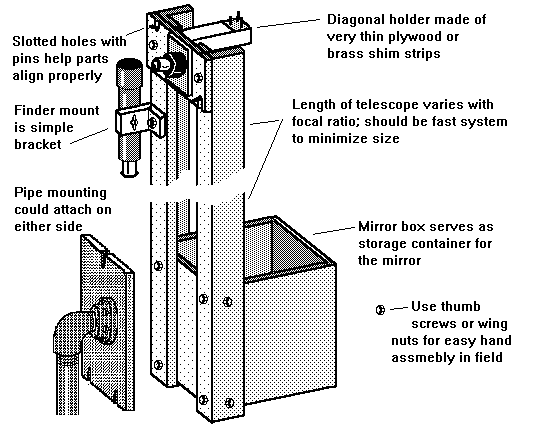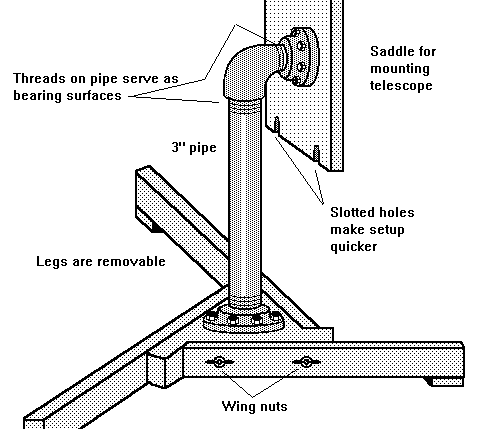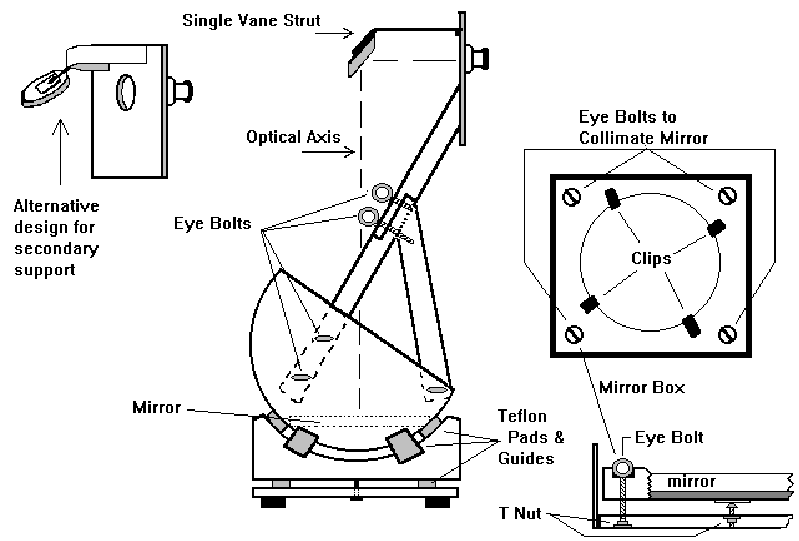Really Portable Telescopes
Roberto Garza & Jack Kramer
We live in interesting times. Amateurs are building ever larger telescopes -- instruments that a generation ago would have been worthy of a professional observatory. Yet we must constantly come to grips with the fact that most of us have to live in light-polluted areas where large telescopes are all but worthless. This means it's necessary to get away as far as possible from urban areas, and to do that, we need telescopes that are manageable. Amateurs have risen to the task with some ingeneous designs that lend themselves to being packed up in the trunk of a car, or even checked along with luggage at an airport.
Some of you may find an ultra-portable telescope fits your needs, so we've re-drawn some designs that were obtained at the 1995 Astrofest. The designer is Thane Bopp, who began building collapsible telescopes some time back when he planned a trip to view a solar eclipse. Roberto has built a 10" telescope similar in concept to one design shown here, and is experimenting with various ways to make it even more portable. These designs acknowledge that if the eyepiece end of the scope can be kept light in weight, then you don't need a massive tube or skeleton structure to support the secondary mirror, eyepiece and focuser, and perhaps a finder. In that case, the tube is replaced with a support structure consisting of only two beams or pipes, or even a single boom. The examples shown here use wooden beams, but hollow aluminum tubing of 1" or 11/2" diameter can be used instead, and Roberto finds it preferable to the wood. Everything is designed to collapse into the smallest possible space for transportation, to be set up quickly, and to be assembled and adjusted in the field without the need for any tools. We'll let the designs provide some ideas for you.

A Collapsible Mounting Too -The Dobsonian mounting is one innovation where the inherent stability and compactness of the altazimuth configuration works to our advantage. However, there is nothing magic in the Dobsonian design, and it can be the bulkiest part of a system that includes a collapsible telescope. On the next page, we have pictured a different design of altazimuth mounting that can be folded into an even more compact package. The way it attaches to a telescope is shown in the above drawing. Of course, the telescope pictured above just as easily could have been fitted out for use with a traditional Dobsonian rocker box. The alternative mounting employs a well used design principle -- the turn-on-threads pipe mount. The piping should be as large as possible, preferably 3" in diameter. The advantage here is that the legs can be made to disassemble easily for transit. The drawback is that it is not as stable as the rocker box, so its use is restricted primarily to scopes of 8" or less.

The Ultimate: a Single Strut Design - Super-portability is afforded by a telescope design that uses a single support beam for the eyepiece holder and secondary, as shown below. The single support connects on one side to the plate that holds the focuser. Obviously, a modification of this design could instead use two beams or a pair of metal tubes, rather than just the single beam. The beam itself even disassembles in the middle for portability. The designer suggests that many wooden parts can be made of two thin marine-grade plywood pieces with styrofoam sandwiched between them; this has proven to be extremely sturdy, yet lighter in weight than a single thick piece of plywood. Eye bolts are used so that all assembly and adjustments can be done without the need for tools.
The base has a semi-circular cross section, which necessitates being able to collimate the mirror from the front, as shown in the lower right corner of the diagram. This is the original design of the mirror mount with the mirror back plate balanced on a single acorn nut. However, this has the potential for stressing the mirror. It would be preferable to have the backplate supported on a set of three equally-spaced springs or flotation pads. An article by Roberto in the January, 1996, issue of NightTimes presented his own design for a mirror cell, which he used on his dual-strut portable telescope.






